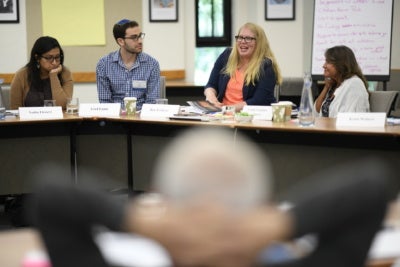It’s hard to come away from the daily news without a growing sense that our country is coming apart at the seams. The increasingly ominous comparisons to previous historical eras of deep division instill a kind of hopelessness. The social problems that we’re facing as a country – fracturing social cohesion, increased polarization, identity wielded as a weapon rather than a bridge – will require nothing less than a full field of powerful social sector leaders working in tandem to create productive change. Yet, despite fieldwide agreement on this fact, there is no clear path to what shape that collaborative effort could take.
Last summer, concerned by the rise in hate crimes, religious bias, and broader social fragmentation, the Aspen Institute Inclusive America project gathered together a cross-sectoral group of leaders to discuss this critical anchoring question: what does the field of religious pluralism look like, and how can those invested in that priority work together toward the achievement of that national vision? The IAP team drew together a set of committed, motivated civic and philanthropic leaders to consider this question collectively, including the organization where I work, Interfaith Youth Core.
 One of the sessions included breaking into smaller groups, where the civic/educational organizations met together to discuss collaborative opportunities while the philanthropic leaders met separately to discuss larger funding trends. While it was a beneficial opportunity to meet with similarly situated organizations, we kept running into certain limitations as well. It seemed obvious that we could and should find ways to collaborate – and yet, the time and effort it would take to identify and advance those collaborations simply didn’t seem worth it. It left me with a lingering sense of opportunities lost.
One of the sessions included breaking into smaller groups, where the civic/educational organizations met together to discuss collaborative opportunities while the philanthropic leaders met separately to discuss larger funding trends. While it was a beneficial opportunity to meet with similarly situated organizations, we kept running into certain limitations as well. It seemed obvious that we could and should find ways to collaborate – and yet, the time and effort it would take to identify and advance those collaborations simply didn’t seem worth it. It left me with a lingering sense of opportunities lost.
As I’ve reflected back on that experience over the past year, I’ve tried to understand the dynamic that played out in that space and others. What is it that makes collaboration hard? To start with, as individual organizations vying for resources and support, there is a certain internal and external pressure to distinguish oneself. First, we need to distinguish ourselves in terms of strategic focus, meaning that we address a unique need in our community or in the broader social sector landscape. Second, we need to distinguish ourselves in terms of programming, showcasing a unique methodology, approach, or ability that addresses our identified social issue in a unique way. Lastly, of course, we need to demonstrate our impact or the particular capacity of our organization to achieve our goals in meaningful, sustainable ways.
All of these are productive pressures that help enforce stronger, more successful social sector organizations, spurred on by a degree of productive competition. However, one unfortunate byproduct is that it also incentivizes organizations to be insular: focused on our own strategy, programming, and impact first and foremost, the success of or failure of which (for some organizations more than others) our very survival is at stake.
Now, this is certainly not to say that the philanthropic sector doesn’t prioritize partnership and collaboration. Far from it; my own organization has been the fortunate beneficiary of many grants to support proactive collaboration with partner organizations. But the urgency of our national moment demands that we consider a much larger question: how do we work together as a field of collaborators to advance religious pluralism across the nation?
Based on my experience working in this field for over a decade, I offer four observations on potential anchors for this type of field-building work:
- Nonprofit and philanthropic leaders alike need to align on a shared vision. To what extent do we have a shared understanding of the long-term aims of our collective work? We need to vividly imagine the social change that we’re trying to achieve as a field and ensure we share a consistent, collective vision. Too often, funders and social sector leaders gloss over differences in priorities and approach, and nonprofit leaders often shape their priorities to fit philanthropic priorities. In order to be moving in tandem towards collective goals, we need to take the time to build consensus around a long-term vision.
- Based on this vision, we need to define field-wide outcomes. How do we define success in this work and what metrics would we use to assess it? Developing a consistent set of collective outcomes and accountability measures establishes an overall framework for change. Utilizing this consistent framework, entities within the field could then discern their unique contributions within the broader field.
- Nonprofit leaders need more formal opportunities for learning and exchange. Collaborations happen best when various entities have a strong understanding of their own unique strengths – and what strengths other entities bring to the table. This type of collaborative communication, in the spirit of learning and exchange, is a valuable opportunity to engage in real-time asset mapping to leverage effective change. Imagine the possibilities of a group of social sector leaders learning from one another and continuously strategizing together on how to align their work.
- Philanthropic partners need to prioritize field-building as essential to long-term impact. Creating the financial support and incentives for this kind of generative, but time-intensive process is an essential element for success. Without it, nonprofit leaders will never be able to break outside of the insular mindsets that are currently necessary to our success. Grants that support field-wide networking, long-term collaboration, and ongoing communication are absolutely key to the strength of an interconnected field.
What would it take to truly become a field with enriching and interlocking partners as opposed to individual entities working alongside but not always with one another? What might we be able to achieve if we took the time – the slow, deliberate planning time – to identify various organizational strengths and needs, field-wide strengths and opportunities, and then to work together to map out a collective impact strategy?
It is incumbent upon us to explore the answers to these questions – the very future of our democracy may depend on it.
Mary Ellen is a senior director at Interfaith Youth Core, where she works to advance innovative programs and strategic partnerships. She is a frequent partner and collaborator of the Inclusive America Project.
The Inclusive America Project is committed to advancing a thriving U.S. Religious Pluralism and believes an important step to achieving this goal is sharing diverse voices and ideas across our platforms. In this spirit, we are pleased to publish blogs written by external authors working in and around the space.
The views and opinions expressed in this blog do not necessarily reflect those of the Aspen Institute.

